
A curtain wall is an exterior covering of a building in which the outer walls are non-structural, instead serving to protect the interior of the building from the elements. Because the curtain wall façade carries no structural load beyond its own dead load weight, it can be made of lightweight materials. The wall transfers lateral wind loads upon it to the main building structure through connections at floors or columns of the building.

Factoria is a mixed-use suburban neighborhood in south Bellevue, Washington and is one of the city's significant commercial districts. Originally timberland from the 1890s to 1920s and later envisioned as an industrial center, Factoria has since the 1960s evolved into commercial and residential development. Factoria was annexed into Bellevue in 1993. The core neighborhood is bounded by Interstate 90 to the north, Interstate 405 to the west, Newport Way to the east, and Coal Creek Parkway to the south.
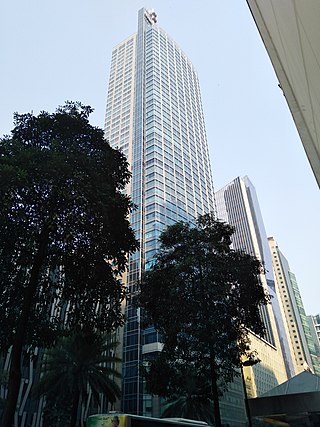
The Philippine Bank of Communications Tower, more commonly known as PBCom Tower, is an office skyscraper ranked officially as the second tallest building in the Philippines. It was previously the tallest building in the Philippines, a title it held starting year 2000 until the completion of Federal Land Tower in early 2017. It has a total ground to architectural top height of 259 metres (850 ft), with 52 storeys including an 8-level radio tower. It is a joint development of Filinvest Asia Corporation (FAC) and the Philippine Bank of Communications (PBCom). The building is the home of PBCom, one of the oldest Philippine banks. The bank occupies the building's first ten floors, with a food court on the seventh floor.

Steel frame is a building technique with a "skeleton frame" of vertical steel columns and horizontal I-beams, constructed in a rectangular grid to support the floors, roof and walls of a building which are all attached to the frame. The development of this technique made the construction of the skyscraper possible.

Metropolitan Tower is a mixed-use skyscraper at 146 West 57th Street in the Midtown Manhattan neighborhood of New York City. Completed in 1987 and designed by SLCE Architects, the building measures 716 ft (218 m) tall with 68 stories. Metropolitan Tower is designed with a black-glass facade, with a rectangular 18-story base topped by a 48-story triangular tower. It was developed by Harry Macklowe.

Huntington, West Virginia's central business district is located to the south of the Ohio River, east of the Robert C. Byrd Bridge, and west of Hal Greer Boulevard. Broad avenues and streets dominate the streetscape, creating for the most part an even grid pattern. Another business district is in Old Central City, known for its numerous antique shops and Heiner's Bakery.
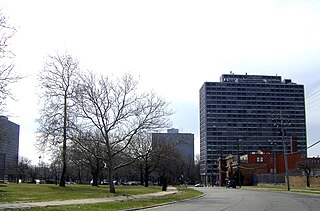
Lafayette Park is a neighborhood located east of Downtown Detroit. It contains a residential area of some 4,900 people and covers 0.07 sq mi.
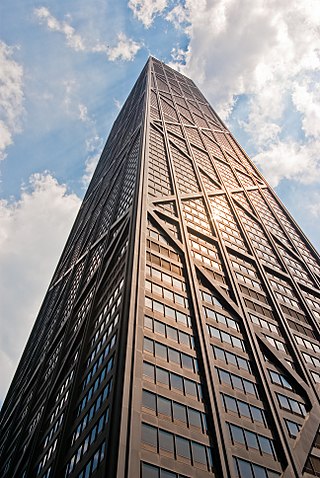
In structural engineering, the tube is a system where, to resist lateral loads, a building is designed to act like a hollow cylinder, cantilevered perpendicular to the ground. This system was introduced by Fazlur Rahman Khan while at the architectural firm Skidmore, Owings & Merrill (SOM), in their Chicago office. The first example of the tube's use is the 43-story Khan-designed DeWitt-Chestnut Apartment Building, since renamed Plaza on DeWitt, in Chicago, Illinois, finished in 1966.

Bellevue Towers is a high rise condominium complex in downtown Bellevue, Washington. Construction began in 2006 and was completed in 2009. The 42 and 43 story towers have 539 condo units, 17,000 square feet (1,580 m2) of retail space, and eight levels of underground parking. The project is 85% sold as of January 2013. Bellevue Towers stands on a 2.43-acre (9,800 m2) site.

The Cube is a 24-storey mixed-use development in the centre of Birmingham, England. Designed by Ken Shuttleworth of Make Architects, it contains 135 flats, 111,500 square feet (10,359 m2) of offices, shops, a hotel and a 'skyline' restaurant. It is the final phase of The Mailbox development.
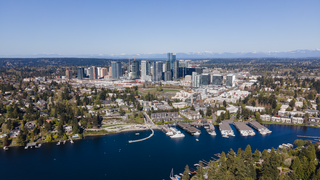
Downtown Bellevue is the central business district of Bellevue, Washington, United States. It is bounded by I-405 to the east, NE 12th Street to the north, 100th Ave NE to the west, and Main Street to the south, and covers an area of around 400 acres (160 ha). It is the second largest city center in Washington state, with more than 50,000 employees and 12,000 residents. Geographically centered near the heart of the Puget Sound region, downtown Bellevue is a regional growth center offering over 9 million square feet (840,000 m2) of Class A office space, various major retail and entertainment locations, more than 2,500 hotel rooms and almost 10,000 housing units.

The University Village is a complex of three apartment buildings located in Greenwich Village in the Lower Manhattan-part of New York City. The complex is owned by New York University and was built in the 1960s as part of the university's transition to a residential college. One of the towers, 505 LaGuardia Place, is a co-op that does not house students, and the other two towers, Silver Tower I and Silver Tower II, house faculty and graduate students of NYU. The buildings were designed by modern architects James Ingo Freed and I. M. Pei, and the central-plaza contains a sculpture by Carl Nesjär and Pablo Picasso. In 2008 the complex was designated a New York City Landmark by the Landmarks Preservation Commission.
Altair is a residential and commercial development under construction in Colombo, Sri Lanka. The building has a 68 floor vertical tower and 63 floor leaning or sloping tower. At 240.0 m (787 ft), the building will be one of the tallest buildings in Colombo when it is completed. The building is situated on the banks of the Beira Lake on a 2-acre plot of land leased by the Urban Development Authority of Sri Lanka to the Developer Indocean Developers. Development was halted for five years, and then restarted in 2020. The first phase of the building opened in March 2021.
Signature Tower was a proposed skyscraper in Jakarta, Indonesia. The proposed height is 638 m (2,093 ft).
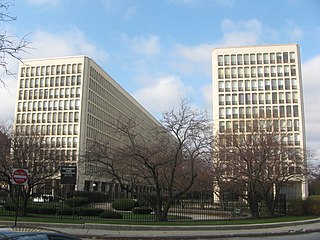
The University Apartments, also known as the University Park Condominiums, are a pair of ten-story towers in Chicago, Illinois designed by I. M. Pei and Araldo Cossutta. The project was part of a city initiative to revitalize the residential development in Hyde Park just north of the University of Chicago. Within the Hyde Park neighborhood, they are colloquially known as "Monoxide Island."
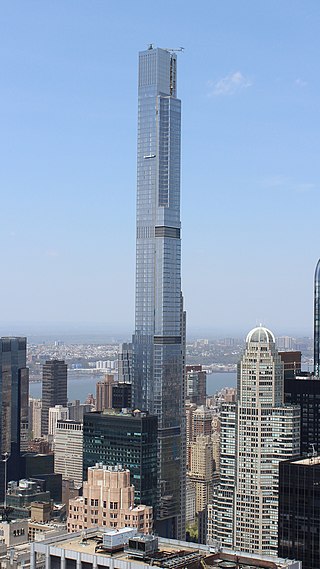
Central Park Tower is a residential supertall skyscraper at 225 West 57th Street in the Midtown Manhattan neighborhood of New York City, along Billionaires' Row. Designed by Adrian Smith + Gordon Gill Architecture, the building rises 1,550 feet (472.4 m) with 98 above-ground stories and three basement stories, although the top story is numbered 136. Central Park Tower is the second-tallest building in New York City, the United States, and the Western Hemisphere; the 15th tallest building in the world; the tallest primarily residential building in the world; and the tallest building outside Asia by roof height.
Chengdu Greenland Tower is a supertall skyscraper currently under construction in Chengdu, Sichuan, China. It will have a height of 468 metres (1,535 ft) with 101 floors. Construction began in 2014 and was halted in early 2019. In mid 2020, construction started back up. When it is completed, it will become the tallest building in Chengdu and southwestern China.

The Spring District is a transit-oriented development and neighborhood that is under construction in Bellevue, Washington. The 16-block, 36-acre (15 ha) development is centered around the Spring District/120th station on the East Link Extension, a light rail line scheduled to open in Spring 2024. It is located in the Bel-Red area between Downtown Bellevue and Redmond, currently used for light industry, roughly bounded on the west by 120th Avenue NE and the Eastside Rail Corridor rail trail, on the north by a King County Metro bus base, on the east by 124th Avenue NE, and on the south by NE 12th Street.
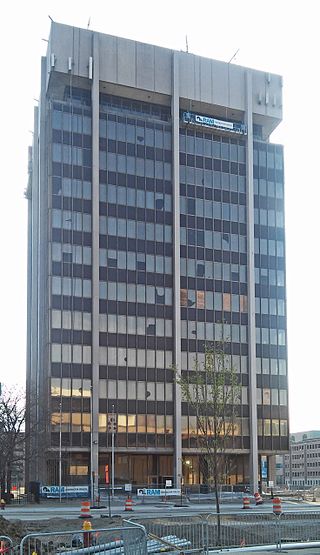
The Professional Plaza Tower, also known as the 'Hammer and Nail' building due to its two iconic illuminated signs, is a high-rise building located at 3800 Woodward Avenue in Midtown Detroit, Michigan. It was listed on the National Register of Historic Places in 2016.

The Hotel Rosita De Hornedo, located in the Puntilla area of Miramar, was one of the first major buildings to be built by a private developer in the 1950s in Havana.

















